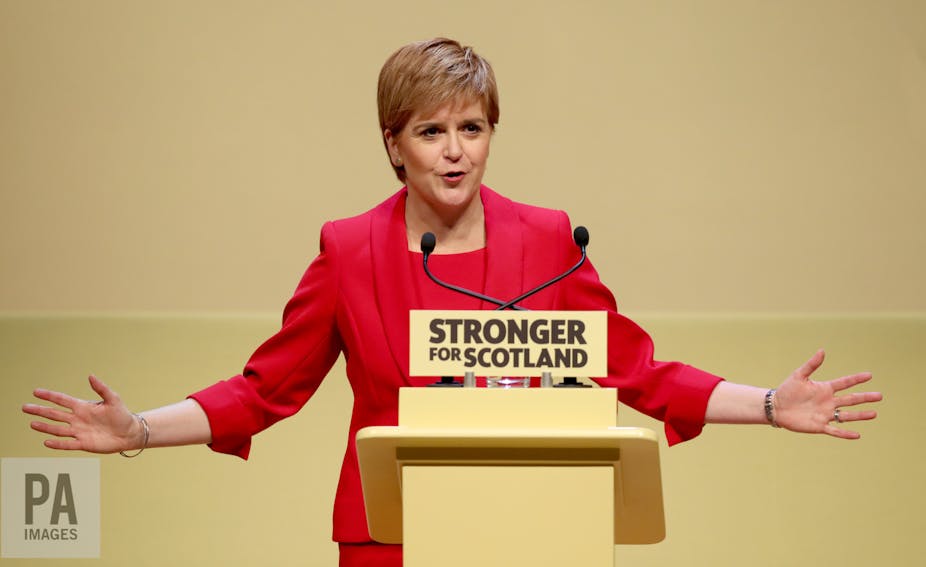The launch of the SNP election manifesto sees the party under more pressure than in some time. The SNP continues to poll very well in Scotland and will surely perform strongly on June 8, but the Conservatives are challenging in a number of seats thanks to Ruth Davidson successfully reinventing her party as the main protectors of the union. How has the SNP responded? Well, conservatively.
The biggest issue for the Scottish Nationalists is of course the independence referendum. The question of a second vote dramatically returned to front and centre after Scots voted enthusiastically to remain in the EU while the rest of the UK voted to leave – upturning the previous premise that the indyref was a “once in a generation” event.
Nicola Sturgeon, the first minister, stepped up the pressure in March by announcing plans for a second indyref in late 2018/early 2019. Theresa May shortly responded that the Scots could have a referendum, but not that quickly, and then called the current election before Sturgeon could announce her next move.
In their 2015 election manifesto, published just a few months after the first indyref, the SNP made no pledge to hold a second independence referendum at all. All mentions of referendums were either about promises made by the No side during the first indyref or about a potential UK-wide vote on EU membership.

This time, the SNP haven’t made any new pledges regarding a referendum either. The manifesto says only that winning a majority of seats in Scotland will signify a “triple lock” that further strengthens the democratic mandate to hold a referendum “when the time is right”. The existing mandate comes from the pro-independence majority at the 2016 Holyrood election and the majority vote in the Scottish parliament in March in favour of Sturgeon’s 2018/19 plan.
The possibility of a second referendum is framed purely as Scotland having a choice on the terms of the Brexit deal. The manifesto says nothing about any perceived advantages from independence.
It is difficult to interpret all this as anything but backtracking – and indeed Sturgeon confirmed after the manifesto launch that there is now no definite date for the second vote. The main reason is the opinion polls, with support for independence pretty much where it was in September 2014. Polling has also shown that the Scottish public are not overly enthused by the idea of another referendum anytime soon.
This could lead to the SNP leaking support, but it is very hard to be sure. The party won just shy of 50% of the Scottish vote in 2015, so the only way is likely to be down – possibly regardless of its position on independence.
The SNP also remains, by far, the strongest pro-independence party and can more or less rely on the vast majority of those who voted Yes in 2014. It therefore has a pretty stable voter base to call upon and so arguably has the capacity to be flexible with its strategy and preferred timetable.
Greatest hits of 2015
Aside from this, much of the 2017 manifesto is a throwback to 2015. The focus on the Conservatives as the party’s main foe in Scotland is sharper, but many of the issues around austerity, social security, tax and defence remain similar.
The party is again calling for the reintroduction of the 50p rate of income tax for top earners, having appeared to cool on it last year. It seeks an end to benefit sanctions (in 2015 it wanted an urgent review), and still wants to ditch the austerity that has been Conservative fiscal policy since 2010.
This continuity is unsurprising: being able to rely on the pro-independence vote takes the pressure off to some extent. The opposition parties were also caught unawares by May’s election announcement, albeit the Conservative lead in the polls should have kept them on guard.
As in 2015, the main slogan is “Stronger for Scotland”. The manifesto repeats the trick of running this alongside a tartanised version of the famous green leather seats in the House of Commons. Historically, the SNP has suffered from the question of relevance at UK elections: why vote SNP when you could vote for another party more likely to participate in government?
This problem mattered less in 2015, and also in 1974, because the constitutional question was high on the agenda. So by trying to play to the same constitutional constituency this time around, the SNP is trying to ensure the benefit continues.

To the same end, the 2017 manifesto has a strong focus on policy areas decided at the UK level, such as defence, foreign affairs and macroeconomic policy. On devolved areas like health and education, it makes a concerted effort to highlight the relevance of the SNP presence in Westminster.
It mentions, for example, the extra funding that will accrue to Scotland depending on what the UK government decides to spend on health in England as a reason for the SNP having a significant presence in the Commons. In fact, the expected Conservative majority would mean strong SNP numbers have practically no impact on this area.
The manifesto also profiles some of the SNP’s most impactful MPs over the past two years – particularly Alison Thewliss, a leading figure in the campaign against the “rape clause” that forces women to prove that the birth of a third child was the result of rape before they can claim tax credits for the child. The message? SNP MPs are hardworking representatives that can bring about positive change in Westminster.
In sum, the SNP’s 2017 manifesto amounts to a pitch for continuity aimed at delivering a mandate for going all out for independence when the timing feels right. It is about consolidation through bringing into sharper focus the new reality that the SNP’s biggest foe is the Conservatives, and arguing that Scotland ought to have a vote on its European future.

